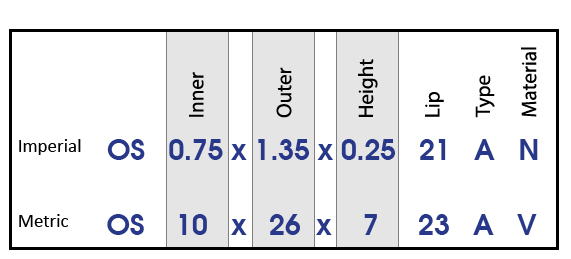Replacing a critical component can be difficult to get right, especially if you do not have the original machine specifications. Thankfully, there are a few ways to identify oil seals; from their design, size and material. As there are hundreds of different oil seals available on the market, this guide will cover the four most common design types. Typically available with either a single or double lip, in Nitrile or Viton Rubber Material.


Oil Seal Single Lip vs Double Lip
Firstly, the oil seals covered in this guide classify the single lip as the inner diameter at the bottom of the component. The single lip is vital to the function of the seal by containing the oil, grease or lubricant. The only difference between a single and double lip is the additional rubber lip on the top of the oil seal which helps prevent dust or dirt from coming close to the shaft. Identifying the oil seal lip can be misinterpreted with a visual inspection alone. For or this reason, you should press along the inner diameter at the top of the seal, if you feel a ridge with a slight movement or give it is highly likely you have a double lipped oil seal.
Industry retailers use unique codes to identify oil seals worldwide. The most common lip style designations are 21 (single lip) and 23 (double lip), please read our Oil Seal Cross Reference Guide for more detailed information.

 Identify Oil Seal Design
Identify Oil Seal Design
1. Type A - Rubber Covered Lip Seals
Fully covered outer diameter for excellent sealing. This oil seal is fully enclosed in a rubber material and is the most widely used type of oil seal. Great resistance to thermal cycling, temperatures and different chemical resistance.
2. Type B - Metal Outer Diameter Oil Seals
Economic metal outer diameter for standard applications. This is an economical oil seal where the metal is exposed on one side and offers a closer fitting between the oil seal and housing or bore. Due to this, it has limited use with sealing thin liquids or gases.
3. Type C - Reinforced Metal Insert Oil Seals
The same design as type B with an additional inner case for greater structural rigidity. This type of oil seal is typically used in heavy-duty engineering machinery or large diameter sized seals
4. Type F - Stainless Steel Garter Spring
The same design as type A with corrosion protected metal case and stainless-steel garter spring. Suitable for use with a wide range of fuels and chemicals.
Identify Oil Seal Material
Nitrile or NBR is black in colour, whereas, Viton or FKM is usually a brownish colour. To understand the main comparisons between the two compounds read our Nitrile vs. Viton article.
How to Measure Oil Seals
Finally, Polymax part codes follow the same pattern as our O-rings - inner diameter, outer diameter and height. This is different from the industry-standard convention, whereby imperial oil seals follow - outer diameter, inner diameter and height.

We hope the information in this article helps you identify the correct oil seal for your application. If you have any queries feel free to call one of our sales engineers on 01420 482862. Polymax stock over 6,000 oil seals available to buy online, browse our oil seal selection today.
